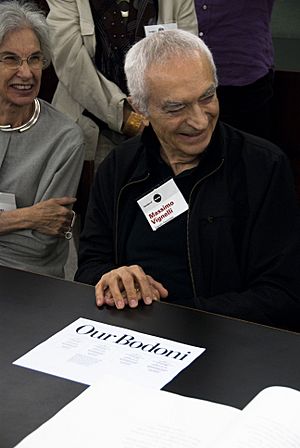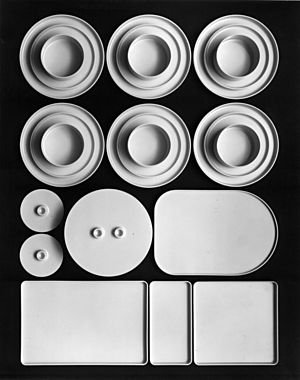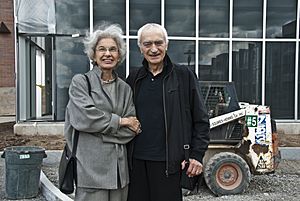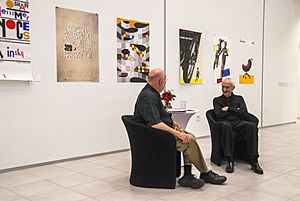Massimo Vignelli facts for kids
Quick facts for kids
Massimo Vignelli
|
|
|---|---|

Massimo Vignelli and Lella at the RIT Cary Graphic Arts Collection with a specimen of his typeface, Our Bodoni.
|
|
| Born | January 10, 1931 |
| Died | May 27, 2014 (aged 83) |
| Nationality | Italian American |
| Education | Politecnico di Milano |
| Occupation | Graphic Designer, Industrial Designer, Architect |
| Organization | Vignelli Associates, Unimark International |
| Spouse(s) | Lella Vignelli |
Massimo Vignelli (born January 10, 1931 – died May 27, 2014) was a famous Italian designer. He created many different things, like packaging, items for homes, furniture, public signs, and even store layouts. He started a design company called Vignelli Associates with his wife, Lella.
Massimo Vignelli believed that "If you can design one thing, you can design everything." This idea showed in all the different types of work he did. His style was very simple and used basic geometric shapes.
Contents
Massimo Vignelli's Life
Massimo Vignelli studied architecture in Italy at the Politecnico di Milano and the Università Iuav di Venezia.
In 1966, he moved to New York City to help start a new design company called Unimark International. This company quickly became one of the biggest design firms in the world. They designed many well-known company logos and looks. For example, they designed the logo for American Airlines.
During this time, Vignelli also designed the famous signs for the New York City Subway system. He also created the subway map used in the 1970s and 80s. He also designed the signs and wayfinding system for the Washington Metro and suggested it be called "Metro."
In 1971, Vignelli left Unimark. He felt that the company was focusing too much on marketing and not enough on good design. Soon after, he and Lella started their own company, Vignelli Associates.
Vignelli worked on a documentary film called Helvetica. This movie was about the popular typeface (a style of letters). He also updated his 1972 New York City Subway map for an online version in 2011. He called it a "diagram" because it was abstract and didn't show streets or parks.
Massimo Vignelli even designed the tables, chairs, and lamps in his own home!
Massimo Vignelli passed away on May 27, 2014, in New York City.
Massimo Vignelli's Work
Vignelli worked on many different kinds of design projects. These included designing interiors, outdoor spaces, packages, graphics, furniture, and products. His company, Vignelli Associates, worked with big companies like IBM, Knoll, Bloomingdale's, and American Airlines.
One of his former employees, Michael Bierut, said that in 1981, "it seemed to me that the whole city of New York was a permanent Vignelli exhibition." He meant that everywhere he looked, he saw something Vignelli had designed, like subway signs or shopping bags.
Vignelli also wrote a book called Vignelli: From A to Z. This book shares his ideas and rules for "all good design." It's organized like an alphabet, with different topics for each letter.
Vignelli's designs were known for being very simple and clean. He used only a few typefaces (font styles) that he thought were perfect. These included Akzidenz-Grotesk, Bodoni, Helvetica, and Century Expanded. He believed that we only need a few good typefaces and should get rid of the rest.
In 2009, Vignelli released a free e-book called The Vignelli Canon. In it, he wanted to share his knowledge to help young designers improve their skills. You can download a PDF version from the Vignelli Center at the Rochester Institute of Technology.
Vignelli also worked with the National Park Service to create the "Unigrid System." This system has been used since 1977 to design brochures for all national parks.
The New York City Subway Map
In August 1972, Massimo Vignelli's design for the New York City Subway map was put up in subway stations. It became a famous example of Modernist design for giving information. Vignelli thought this map was one of his best creations.
Why a New Map Was Needed
In the mid-1960s, the New York City subway system had problems helping riders find their way.
- The signs were old and confusing.
- Many visitors came for the 1964 New York World's Fair, and it was hard for them to use public transportation.
- Changes to the subway lines made the old maps even more confusing.
To fix this, the subway system hired Len Ingalls, who asked Massimo Vignelli to help. In 1966, Vignelli's company, Unimark, was hired to redesign the subway signs and look at the maps.
The 1970s Vignelli Map
The subway system released a new map in 1967, but it was still confusing. So, in 1970, the Metropolitan Transportation Authority (MTA) asked Unimark to design a completely new map.
Joan Charysyn worked on putting the map together under Vignelli's guidance. Even after Vignelli left Unimark in 1971, the map was almost finished. It was officially shown to the public on August 4, 1972.
After 1972, Vignelli didn't control the map anymore. The MTA made several changes to it. In 1979, a new, more geographic map replaced Vignelli's design. This new design is still used today.
The 2000s Vignelli Map
In 2007, a magazine asked Vignelli to create a special version of his map. Vignelli and his team, Yoshiki Waterhouse and Beatriz Cifuentes, decided to make a brand new, updated map. They made sure that if one station was east of another in real life, it would also be east on the map. This fixed a common criticism of the 1972 map.
Their new map was released in May 2008. It was so popular that 500 signed prints sold out in hours!
In 2011, the MTA asked Vignelli to create a digital version of the 2008 map. This digital map is used on the MTA's Weekender website to show subway service changes every week.
Super Bowl Map
Massimo Vignelli also helped with a special transit map for Super Bowl XLVIII in 2014. This game was played in New Jersey.
Since private cars weren't allowed at the stadium, many people used public transportation. The MTA worked with other transit companies to create a special map. This map was unique because:
- It showed both New York and New Jersey.
- It included the New York City Subway, other MTA train lines, New Jersey Transit lines, and Amtrak lines.
- It was the first time since 1979 that a Vignelli map was printed on paper.
- It even showed some landmarks like the MetLife Stadium.
Vignelli Center for Design Studies
In 2008, Massimo and Lella Vignelli gave all their design work to the Rochester Institute of Technology. This collection is kept in a special building called The Vignelli Center For Design Studies. Lella and Massimo Vignelli designed the building themselves. It opened in September 2010 and has exhibition spaces, classrooms, and offices.
Awards and Honors
Massimo Vignelli received many awards and honorary doctorates (special degrees) for his amazing work:
- 1964 – Gran Premio Triennale di Milano
- 1964, 1998 – Compasso d’Oro, from (ADI), Italian Association for Industrial Design
- 1973 – Industrial Arts Medal of the American Institute of Architects (AIA)
- 1982 – New York Art Directors Club Hall of Fame
- 1982 – Honorary Doctorate in Fine Arts from Parsons School of Design, New York
- 1983 – AIGA Gold Medal
- 1985 – first Presidential Design Award, presented by President Ronald Reagan, for the National Park Service Publications Program
- 1987 – Honorary Doctorate in Fine Arts from Pratt Institute, Brooklyn, New York
- 1988 – Interior Design Hall of Fame.
- 1988 – Honorary Doctorate in Fine Arts from Rhode Island School of Design, Providence, Rhode Island
- 1991 – National Arts Club Gold Medal for Design
- 1992 – Interior Product Designers Fellowship of Excellence
- 1993 – New York State Governor’s Award for Excellence
- 1994 – Honorary Doctorate in Architecture from the University of Venice, Italy
- 1994 – Honorary Doctorate in Fine Arts from Corcoran School of Art, Washington D.C.
- 1995 – Brooklyn Museum Design Award for Lifetime Achievement
- 1996 – Honorary Royal Designer for Industry Award, Royal Society of Arts, London
- 2000 – Honorary Doctorate in Fine Arts from Art Center College of Design, Pasadena, California
- 2002 – Honorary Doctorate in Fine Arts from Rochester Institute of Technology, Rochester, New York
- 2003 – National Lifetime Achievement Award from the National Museum of Design at Cooper-Hewitt, New York
- 2004 – Visionary Award from the Museum of Art and Design, New York
- 2005 – Architecture Award from the American Academy of Arts and Letters, NY









